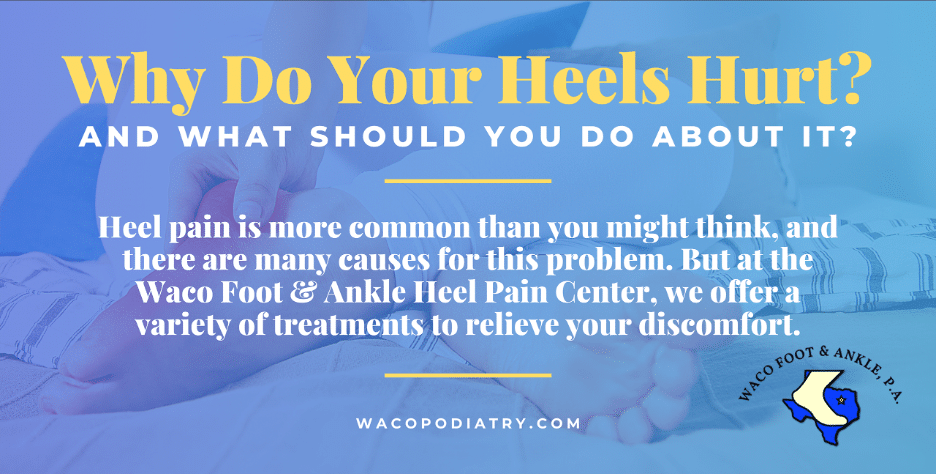Why Do Your Heels Hurt (And What Should You Do About It?)
On an average day here at our Waco Foot & Ankle office, we will treat several patients suffering from painful heels. This is a problem that is more common than you might think, but heel pain is merely a symptom caused by an underlying foot condition – and there are many foot conditions that can affect your heels!
From plantar fasciitis to Achilles tendinitis to Sever’s disease, the potential culprits to your discomfort are many, and finding out the root cause of your heel pain is the first step to determining the best treatment for you. If heel pain is keeping you from enjoying life to its fullest, or simply making routine tasks harder than they should be, come visit our office for the effective foot care you need.
Our heel pain center is fully equipped with the best tools available to get you back on your feet – without heel pain! (More on that in a bit.)
But first, let’s find out why your heels are complaining.

Finding the Culprit
When was the last time you minded the well-being of your feet? The truth is most of us take these hard-working appendages for granted (that is, until they start giving us a reason to worry, like when heel pain comes into picture).
With all the force impact our feet endure daily, it’s really no surprise that problems do start to arise over time. In fact, our feet absorb up to four times our body weight whenever we stand, walk, run, or jump! And, since the heels are the first part of the feet that meet the ground with each and every step we take, there’s a reason why pain in that area is the most common complaint we hear from patients.
However, the underlying cause for this type of discomfort varies. Some of the most common culprits for heel pain include:
- Plantar fasciitis. This condition develops when the fibrous band of tissue running along the bottom of the foot (the plantar fascia) sustains tears due to excessive stress. Usually, patients will experience sharp, intense pain in the bottom of the heel upon rising out of bed in the morning or after extended periods of rest or inactivity.
- Achilles tendinitis. This condition develops when intense physical activity is suddenly performed, or the Achilles tendon becomes inflamed due to overuse. Usually patients will experience pain in the back of the heel that becomes worse during and following physical activity.
- Sever’s disease. This condition is the leading cause for heel pain in adolescents. Sometimes the heel bone can reach physical maturity before the Achilles tendon, and this causes pulling in the back of the heel.
Stress fractures, bursitis, heel spurs, pinched nerves and Haglund’s deformity are also conditions that cause heel pain, though these are not as common as the conditions listed above. Regardless of what is causing your discomfort, however, it’s important that you seek appropriate treatment. Doing so will not only relieve existing symptoms, but also help prevent long-term issues.
Preventing the Pain
Once we find the underlying cause of your discomfort, we can then determine which treatment methods will be best to address the problem. The good news is conservative options are usually able to provide significant relief – if not altogether eradicate the issue.
Wearing custom orthotics, for instance, is a great way to not only relieve painful symptoms but also correct the problem at its very source. Often these versatile devices, coupled with routine stretching exercises, are enough to get patients back on their feet and doing the things they love most.
Here are some other things to keep in mind when preventing and managing heel pain at-home:
- Choose the right footwear. Make sure you have the right shoes for your sports and exercises. Always pick footwear that fits correctly and provides ample cushioning and arch support. Avoid shoes with heels higher than 2 inches; these will result in excessive tension on the connective tissues in your feet and lower legs.
- Gradually increase your level of physical activity. When you are starting a new running or exercise program, give your body some time to adjust to the increased forces you are placing on it. Start any new workout program at an easy level and then slowly ramp up your intensity and duration over time.
- Stretch before and after exercising. Take about 5-10 minutes for a proper warmup, followed by some dynamic stretches targeting the muscles you are going to use.
- Do some cross-training. Mix in a couple sessions of yoga, cycling, swimming, or even walking in your exercise routine to reduce the total amount of physical stress on your feet and heels.
Treating the Problem at Waco Foot & Ankle Heel Pain Center
Now, for those cases of heel pain that are more severe and do not respond to conservative approaches, there is still hope for you too!
At our Waco Foot & Ankle office, we are proud to offer many state-of-the-art treatment options for heel pain. These methods are extremely effective in relieving chronic pain and have helped many patients avoid the need for surgery. They include:
- Stem Cell Therapy. This treatment method uses stem cells to boost your body’s own natural healing processes.
- Multiwave Locked System (MLS) Laser Therapy. This treatment method uses very precise laser wavelengths to heal soft tissue injuries.
Whereas the vast majority of heel pain cases can be treated conservatively, there are also cases that are best resolved with surgical care. In such instances, we will discuss your options, let you know what to expect from every step of the procedure, and answer any questions you might have.
The best way to know exactly why your heel hurts and what needs to be done about it is coming to our office so we can evaluate the problem for you. Foot pain is something that should not be ignored, so make sure you contact us for the expert diagnosis and treatment you need. Call our office at (254) 776-6995 today or fill out our online contact form to have one of our staff members reach out to you.
